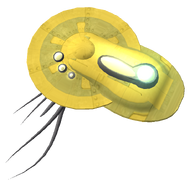Superluminal Communication[]
Hyperspace Aerial[]

A hyperspace aerial of Sanuran design. The Gestirn cell takes up the majority of the machine.
Hyperspace aerials are used to transmit information at apparently superluminal speeds by sending signals through Hyperspace. These machines work on the principle that portals into hyperspace can be open on the subatomic scale for a fraction of a second using Planck-scale energy densities.
These Planck-scale energy densities are achieved by using high powered grasers the create quantum scale kugelblitzes inside reinforced vacuum chambers called Gestirn Cells. These lasers typically get the energy they need from a dedicated Antimatter Reactor or from the main antimatter reactor on board a spaceship. These black holes will rapidly decay by way of hawking radiation which will produce Planck energy photons.
A powerful beam of radio waves is then sent through the portal, targeted specifically at the desired Hyperspace Reciever to keep the signal coherent over the vast distance it needs to traverse. As the radio-photons enter hyperspace, they become Tachyons.The hyperspace portal is not very stable and can only be held open for a fraction of a second. This means that the information encoded in a hyperspace signal must be extremely compressed. This is typically done by a quantum computer that converts the signal into a polynary code before transmission.
Hyperspace TRAN[]
A Hyperspace Transmission Receiver Aerial Nexus (Hyperspace TRAN) is needed to receive superluminal signals transmitted by a hyperspace aerial. These work similarly to a Hyperspace aerial, opening a portal into hyperspace using a kugelblitz generator, this time to allow tachyons out of hyperspace to be absorbed and interpreted as a compressed signal by a quantum supercomputer. However, as it is unknown exactly when a signal will be transmitted to the portals must be open at all possible times. This costs enormous amounts of energy which leads to hyperspace TRANs being very expensive and large, usually only one spaceborne facility per solar system. In order to cut down on the energy cost, the portals are only opened for a fraction of a second at regular intervals. To ensure that a signal does not arrive while the portals are closed, every long-distance ship is equipped with an internal chronometer in sync with the TRAN that scales with the distance the ship has traveled, ensuring that signals can only be sent at a time where by the time they arrive, the portals will be open. The delay between openings is usually not more than a few seconds but since this is many orders of magnitude higher than the time that the portals are actually opened for, this reduced the amount of energy needed exponentially.
Personal[]
Head Drives[]

A basic head drive of Bombari design. Approximately 5cm across
All species in the Perseus coalition make use of a computer memory implanted into an individuals body, commonly referred to as a 'head drive'. Due to the wildly different physiology of the many Coalition species, these greatly vary in design and were usually developed independently by the individual races before the Coalition formed. The head drive was first developed by the Sanurans due to their silicon-based physiology making it much easier for the technology to interface with the body. In the case of the Virloyds the colloquial name is inaccurate as the Virloyd brain, where the drive is implanted, is located in the abdomen.
Head drives are typically used as a more reliable form of memory to augment the natural memory of an individual as computer memory is more reliable at retaining detail, can be indexed much more efficiently and has the possibility of deleting certain memories. Typically, the actions of an individual are recorded separate by a camera in the eye or by tapping into the optic nerve, the footage being stored in the head drive for later review through an external monitor or by direct interface with the optic nerve to replay the electronic memory, commonly called an emem. Recording can be constant, recording everything seen by the individual or can be activated for specific situations that require high memory retention.
Other functions common to the head drive are an internal calculator, allowing a person to instantly calculate complex equations while working and sometimes allowing interface with a network, allowing for communication and research without the need for an external device.



